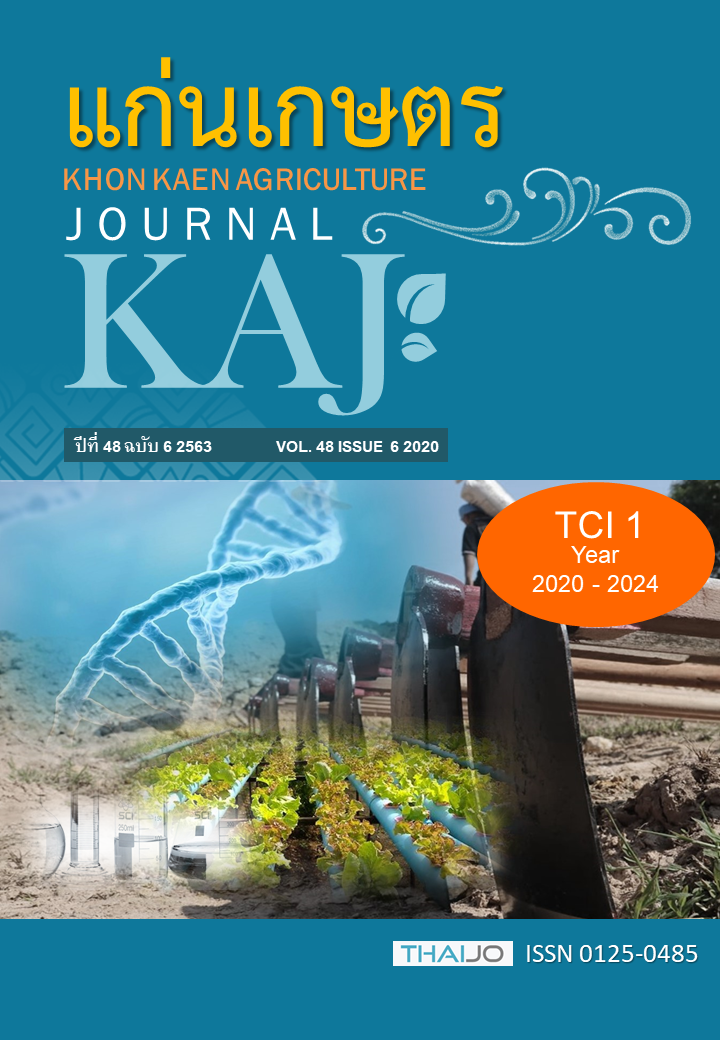การระบุชนิดเชื้อราสาเหตุโรคผลเน่าของมะม่วงเขียวเสวยในพื้นที่การผลิตจังหวัดเลยเพื่อการส่งออก
Main Article Content
บทคัดย่อ
การระบุชนิดเชื้อราสาเหตุโรคผลเน่าของมะม่วงเขียวเสวยเพื่อการส่งออกจากพื้นที่การผลิตในจังหวัดเลย โดยแยกเชื้อราสาเหตุโรคผลเน่าได้จำนวน 7 ไอโซเลต เมื่อนำมาทดสอบความสามารถในการก่อโรค พบว่าทุกไอโซเลตทำให้เกิดอาการผลเน่าบนมะม่วงเขียวเสวย เมื่อระบุสกุล (genus) โดยอาศัยลักษณะทางสัณฐานวิทยา พบว่า ไอโซเลต KWS1 มีลักษณะคล้ายกับ Colletotrichum sp. ไอโซเลต KWS4, KWS5, KWS6 และ KWS12 คล้ายกับ Lasiodiplodia sp. ส่วน KWS7 และ KWS9 คล้ายกับ Fusicoccum sp. หลังจากการระบุชนิด (species) ด้วยเทคนิคชีวโมเลกุลโดยเพิ่มปริมาณดีเอ็นเอในส่วน internal transcribe spacer ของ rDNA (ITS1-5.8S-ITS2) และบริเวณ translation elongation factor 1-alpha (EF1-α) gene ด้วยเทคนิค PCR พบว่า ได้ PCR product ขนาด 500 และ 550 คู่เบส ตามลำดับ เมื่อนำลำดับนิวคลีโอไทด์ไปเปรียบเทียบกับฐานข้อมูล GenBank พบว่า ไอโซเลต KWS1 มีความเหมือนกับ Colletotrichum gloeosporioides ไอโซเลต KWS4 และ KWS6 มีความเหมือนกับ Lasiodiplodia pseudotheobromae ไอโซเลต KWS5 และ KWS12 มีความเหมือนกับ Lasiodiplodia theobromae ไอโซเลต KWS7 และ KWS9 มีความเหมือนกับ Fusicoccum fabicercianum และ Neofusicoccum parvum ตามลำดับ
Article Details
References
พงศธร ธรรมถนอม และปริญญา จันทรศรี. 2554. การจำแนกชนิดในระดับโมเลกุลของเชื้อราสาเหตุโรคแอนแทรกโนสจากตัวอย่างในสวนมะม่วงน้ำดอกไม้สีทอง อำเภอพร้าว จังหวัดเชียงใหม่. วารสารวิทยาศาสตร์เกษตร 42 (พิเศษ): 31-34.
สุวิตา แสไพศาล. 2554. การกระตุ้นความต้านทานโรคทางใบด้วยเชื้อราปฏิปักษ์ Trichoderma spp. และการส่งถ่ายยีนไคติเนสจากเชื้อรา Trichoderma spp. เพื่อปรับปรุงพันธุ์มะเขือเทศให้มีความต้านทานต่อโรคเชื้อรา. วิทยานิพนธ์ปริญญาปรัชญาดุษฎีบัณฑิต สาขาวิชาโรคพืชวิทยา บัณฑิตวิทยาลัย มหาวิทยาลัยขอนแก่น.
สำนักงานเศรษฐกิจการเกษตร กระทรวงเกษตรและสหกรณ์. 2559. สถิตินำเข้าส่งออก. แหล่งข้อมูล http://www.oae.go.th/oae_report/export _import/export_result.php. ค้นเมื่อ 22 กรกฎาคม 2562.
อุราภรณ์ สะอาดสุด วิชชา สะอาดสุด และโสภณ สิงห์แก้ว. 2548. การประเมินความเสียหายในมะม่วงพันธุ์น้ำดอกไม้หลังการเก็บเกี่ยว. Postharvest Newsletter 4: 1-4.
Alves, A., P.W. Crous, A. Correia, and A.J.L. Phillips. 2008. Morphological and molecular data reveal cryptic speciation in Lasiodiplodia theobromae. Fungal Diversity 28: 1-13.
Abdollahzadeh, J., A. Javadi, E.M. Goltapeh, R. Zare, and A.J.L. Phillips. 2010. Phylogeny and morphology of four new species of Lasiodiplodia from Iran. Persoonia 25: 1–10.
Boonsiri, A. and J. Siriphanich. 2007. How to export mangoes. Kasetsart University. Press. Bangkok. 37p.
Dinh, S.Q., J. Chongwungse, P. Pongam, and S. Sangchote. 2003. Fruit infection by Colletotrichum gloeosporioides and anthracnose resistance of some mango cultivars in Thailand. Australasian Plant Pathology 32: 533–538.
Kamle, M., B.K. Pandey, P. Kumar, and M.M. Kumar. 2013. A species-specific PCR based assay for rapid detection of mango anthracnose pathogen Colletotrichum gloeosporioides Penz. and Sacc. Journal of Plant Pathology and Microbiology 4: 1-5.
Kimura, M. 1980. A simple method for estimating evolutionary rate of base substitutions through comparative studies of nucleotide sequences. Journal of Molecular Evolution 16: 111-120.
Lim, L., M.H. Mohd, and L. Zakaria. 2019. Identification and pathogenicity of Diaporthe species associated with stem-end rot of mango (Mangifera indica L.). European Journal of Plant Pathology 155: 687-696.
López, B.A., J.A. Ragazzo-Sánchez, R. Allende- Molar, G.D. Avila-Quezada, and M. Calderon-Santoyo. 2015. Colletotrichum gloeosporioides from mango Ataulfo: morphological, physiological, genetic and pathogenic aspects. Journal of Research in Biology 5: 1641-1647.
Marques, M.W., N.B. Lima, M.A. de Morais Jr, S.J. Michereff, A.J.L. Phillips, and M.P.S. Câmara. 2013. Botryosphaeria, Neofusicoccum, Neoscytalidium and Pseudofusicoccum species associated with mango in Brazil. Fungal Diversity 61:195–208.
Ni, H.F., H.R. Yang, R.S. Chen, R.F. Liou, and T.H. Huang. 2012. New Botryosphaeriaceae fruit rot of mango in Taiwan: identification and pathogenicity. Botanical Studies 53: 467-478.
Pavlic, D., B. Slippers, T.A. Coutinho, M. Gryzenhout, and M.J. Wingfield. 2004. Lasiodiplodia gonubiensis sp. nov., a new Botryosphaeria anamorph from native Syzygium cordatum in South Africa. Studies in Mycology 50: 313-322.
Phillips, A.J.L., A. Alves, A. Correia, and J. Luque. 2005. Two new species of Botryosphaeria with brown, 1-septate ascospores and Dothiorella anamorphs. Mycologia 97: 513-529.
Sardsud, U., V. Sardsud, and S. Singkaew. 2003. Postharvest loss assessment of mango cv. Nam Doc Mai. Postharvest Technology Research Institute, Chiang Mai University. 62p.
Slippers, B., G.I. Johnson, P.W. Crous, T.A. Coutinho, B.D. Wingfield, and M.J. Wingfiel. 2005. Phylogenetic and morphological re-evaluation of the Botryosphaeria species causing diseases of Mangifera indica. Mycologia 97: 99–110.
Swamy, J.S. 2012. Anthracnose- A devastating pre and post-harvest disease in mango. Internat. Journal of Plant Protection Research 5: 429-437.
Tamura, K., G. Stecher, D. Peterson, A. Filipski, and S. Kumar. 2013. MEGA6: Molecular evolutionary genetics analysis verison 6.0 Molecular Biology and Evolution 30: 2725-2729.
Thompson, J.D., D.G. Higgins, and T.J. Gibson. 1994. Clustal W: Improving the sensitivity of progressive multiple sequence alignment through sequence weighting, position-specific gap penalties and weight matrix choice. Nucleic Acids Research 22: 4673-4680.
Trakunyingcharoen, T., R. Cheewangkoon, C. To-anun, P.W. Crous, J.M. van Niekerk, and L. Lombard. 2014. Botryosphaeriaceae associated with diseases of mango (Mangifera indica). Australasian Plant Pathology. 43: 425-438.
Trakunyingcharoen, T., L. Lombard, J.Z. Groenewald, R. Cheewangkoon, C. To-anun, and P.W. Crous. 2015. Caulicolous Botryosphaeriales from Thailand. Persoonia. 34:87-99.
White, T.J., T. Bruns, S. Lee, and J. Taylor. 1990. Amplification and direct sequencing of fungal ribosomal DNA for phylogenetics, p. 315-322. In M.A. Innes, D.H. Gelfand, J.J. Sninsky, and T.J. White (ed.) PCR protocols: a guide to methods and applications. Academic Press, Inc., San Diego, Calif.

